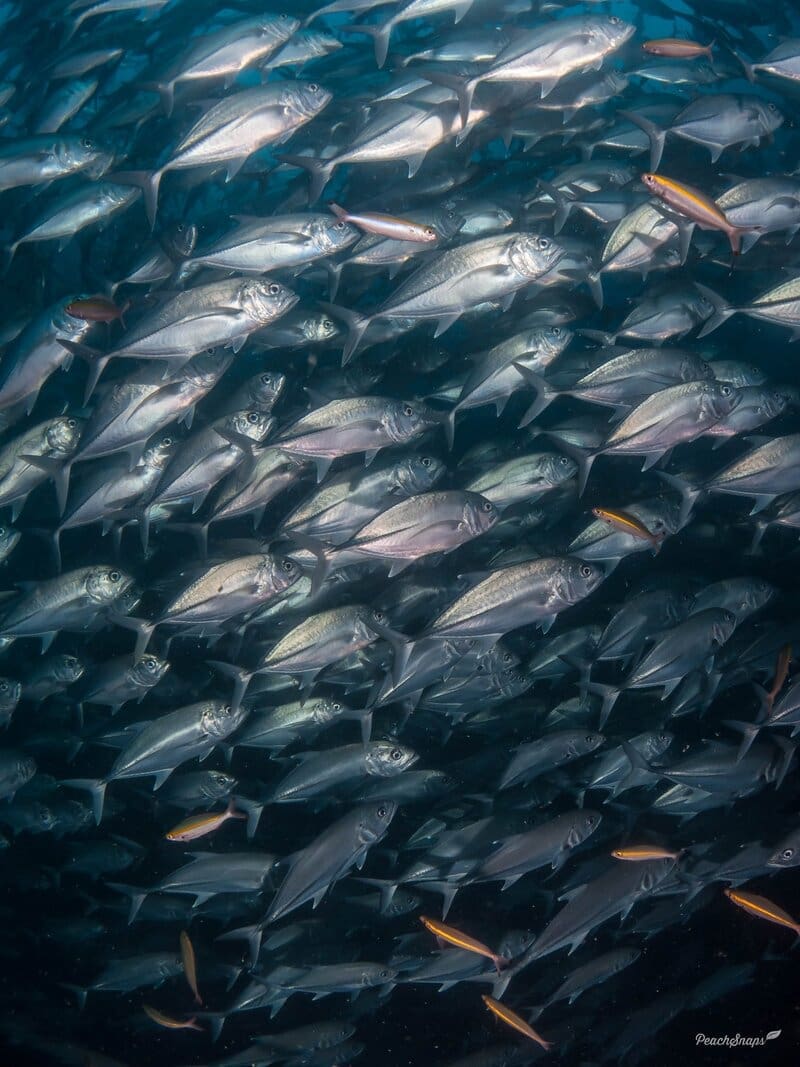The bigeye trevally (Caranx sexfasciatus) is one of the most fascinating fish to encounter in tropical waters, often seen forming large, mesmerizing schools near coral reefs. Known for their silvery bodies, prominent eyes, and remarkable speed, these fish are not only visually striking but also essential predators in marine ecosystems. Let’s explore the intriguing facts, behaviors, and interesting encounters with the bigeye trevally, a species that never fails to impress divers and snorkelers alike.

Appearance and Habitat
Bigeye trevallies are named for their unusually large eyes, which help them hunt in low-light conditions such as dusk or dawn. These fish are typically silver with a slightly bluish or greenish hue, and they can grow up to 3 feet (1 meter) in length, though most are about 1-2 feet long. Their sleek, streamlined bodies make them incredibly fast swimmers, allowing them to catch small fish, crustaceans, and cephalopods with ease.
They are most commonly found in warm, tropical waters of the Indo-Pacific region, particularly around coral reefs and lagoons. While juveniles tend to stick closer to the shore, adult bigeye trevallies can often be found cruising deeper waters or forming enormous schools that move as one, creating spectacular underwater displays.
Behavior and Diet
Bigeye trevallies are predatory fish, primarily hunting at night. Their diet consists of smaller fish, squid, and crustaceans, which they hunt by using their keen eyesight to spot prey in dim light. During the day, these fish often gather in large schools, a behavior thought to protect them from predators like sharks and larger fish. This schooling behavior also makes them a favorite subject for underwater photographers, as the swirling formations of silvery fish create captivating visuals.
One amusing story often shared by divers involves the experience of swimming into a massive school of bigeye trevally. While the fish typically part to avoid contact, they sometimes circle divers out of curiosity, enveloping them in a shimmering vortex of fish. One diver described feeling like they were in a “fish tornado,” surrounded on all sides by hundreds of glistening trevallies, only to have the school suddenly disperse and reform as if nothing had happened. It’s a surreal and unforgettable experience that highlights the coordinated behavior of these fascinating creatures.
Are Bigeye Trevallies Dangerous?
Despite their sharp looks and predatory habits, bigeye trevallies pose no danger to humans. They are not aggressive, and their large schools are more interested in avoiding predators than interacting with divers. In fact, these fish are often considered shy, quickly darting away if they feel threatened or disturbed. While their impressive size and schooling behavior might make them seem intimidating at first glance, bigeye trevallies are completely harmless to people.
Conservation Status
Bigeye trevallies are not currently considered endangered, but they face threats from overfishing and habitat destruction, particularly in coral reef areas. As a species that plays a crucial role in maintaining the balance of marine ecosystems, their well-being is closely tied to the health of the reefs and lagoons they inhabit. Coral bleaching, pollution, and unsustainable fishing practices all pose risks to their populations, making conservation efforts increasingly important.
Why Bigeye Trevallies Matter
These fish are more than just a stunning underwater sight. Bigeye trevallies are vital to the health of coral reef ecosystems, acting as both predators and prey in the food chain. By controlling populations of smaller fish and invertebrates, they help maintain a balanced ecosystem that supports a wide variety of marine life. For divers and snorkelers, encountering a school of bigeye trevally is a reminder of the beauty and complexity of life beneath the waves.
Frequently Asked Questions About Bigeye Trevally
What is a Bigeye Trevally?
A: The Bigeye Trevally (Caranx sexfasciatus) is a species of large, fast-swimming fish found in tropical and subtropical oceans. Recognizable by their silvery bodies and prominent eyes, they are known for forming large, mesmerizing schools near coral reefs.
Where are Bigeye Trevallies commonly found?
A: Bigeye Trevallies inhabit the warm waters of the Indo-Pacific region, often around coral reefs and lagoons. They are typically found at depths ranging from the surface to about 100 meters.
What do Bigeye Trevallies eat?
A: These predatory fish primarily feed on smaller fish, crustaceans, and cephalopods. They are known to hunt in groups, using coordinated movements to herd and capture their prey.
Are Bigeye Trevallies dangerous to humans?
A: Bigeye Trevallies are not considered dangerous to humans. They are generally shy and tend to avoid divers. However, as with all wildlife, it’s best to observe them respectfully and avoid sudden movements.
Why do Bigeye Trevallies form large schools?
A: Schooling provides several advantages, including protection from predators, increased hydrodynamic efficiency, and improved foraging success. The synchronized movements of these schools are a defense mechanism and a hunting strategy.
Final Thoughts
The bigeye trevally is an impressive fish with a unique combination of beauty, speed, and predatory skill. Whether you’re observing them solo or swimming through a swirling school, these fish offer an unforgettable experience. Protecting their habitats and ensuring sustainable fishing practices will help preserve their populations for future generations to enjoy.Check out our next article about: Black Tip Reef Sharks
Check out our next article about: Black Tip Reef Sharks


Leave a Reply